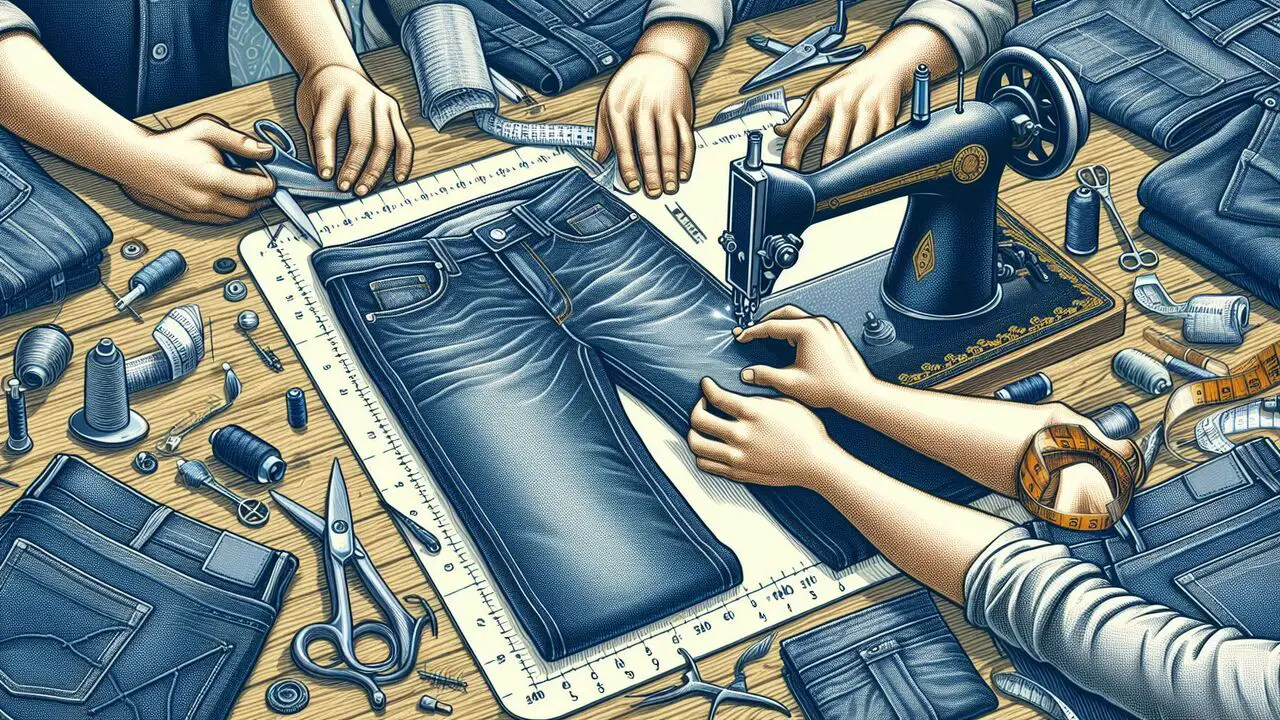Jeans are a wardrobe staple for everyone. From high-end designer brands to fast fashion, jeans come in all shapes, sizes, and price ranges. But have you ever wondered how much goes into making a pair of jeans?
Here, we will explore the factors that influence the cost of jeans and break down the production process step-by-step, from choosing materials to marketing and retail markups.
We’ll also discuss pricing strategies and variations across different brands and retailers. Whether you’re a consumer looking to make an informed purchase or someone interested in the economics behind clothing production, keep reading to learn everything you need about the cost of jeans.

Jeans Making Cost In Details

The cost of jeans is a topic of interest for consumers and manufacturers alike. Understanding the factors contributing to the final price of a pair of jeans requires a detailed analysis of the various steps involved in the production process.
From sourcing raw materials to the final finishing touches, each stage incurs costs that ultimately determine the retail price. Here, we discuss the cost of making jeans in detail.
1. Raw Materials cost:
- Denim Fabric: The cost varies depending on quality, weight, and origin. Typically, it ranges from $2 to $15 per yard.
- Thread: Essential for stitching; costs around $0.50 to $1 per spool.
- Zippers and Buttons: Quality can affect price. Zippers can cost between $0.25 to $1 each, while buttons and rivets may add another $0.10 to $0.50 per pair of jeans.
- Labels and Tags: Brand labels, care tags, and price tags cost approximately $0.10 to $0.50 per pair.
2. Labor Cost:
- Cutting and Sewing: Labor costs depend on the country of production. In low-cost countries, labor might be as low as $1 to $5 per pair, whereas in high-cost countries, it can range from $10 to $20 or more.
- Washing and Finishing: Processes like stone washing, distressing, and other finishes can add $1 to $5 per pair.
3. Overheads:
- Factory Overheads: This includes electricity, rent, maintenance, and machinery costs. Estimated to be around $0.50 to $2 per pair.
- Administrative Costs: Salaries of management and administrative staff, marketing, and other operational costs, which might add another $1 to $3 per pair.
4. Logistics:
- Shipping costs involve transporting raw materials to the factory and finishing goods to the distribution center. Depending on distance and mode of transportation, they can range from $0.50 to $2 per pair.
5. Taxes and Duties:
- Import/Export Duties: Depending on the country, there may be additional costs for import/export taxes. This can vary widely but might add another $1 to $5 per pair.
Total Cost Estimate:
The total production cost for a pair of jeans produced in a low-cost country might range from $6 to $15. In high-cost countries, the cost could be between $15 and $30 or more. When these jeans reach the retail market, prices can range from $30 to $200 or more, depending on the brand, quality, and marketing strategy.
Factors To Consider When Determining The Value Of Jeans

When determining the value of jeans, there are several factors to consider. These factors can vary depending on the jeans’ brand, style, and quality. Here are some key factors to keep in mind:
- Brand Reputation: Jeans from well-known and reputable brands tend to have higher prices due to their established reputation for quality and style.
- Material: The type of fabric used in the jeans can impact their cost. Premium denim made from high-quality materials is generally more expensive than lower-quality denim.
- Construction: The construction of the jeans, including details such as stitching and hardware, can affect their price. Jeans with intricate details or unique design elements may be more expensive.
- Fit And Style: Different fits and styles of jeans cater to different preferences and body types. Specialty fits or trendy styles may be priced higher due to their uniqueness or popularity.
- Production Process: How jeans are made can also influence their cost. Ethical sourcing and sustainable manufacturing practices may contribute to a higher price tag.
It is important to note that these factors can vary greatly, and ultimately, the value of jeans is subjective. It is crucial to balance quality, style, and affordability when determining the worth of jeans that fit your personal preferences and budget.
Conclusion
The cost of jeans varies depending on various factors, such as materials, manufacturing processes, branding, marketing, and retail markups. Different brands and retailers have pricing strategies, which contribute to the price variation.
When determining jeans’ worth, it is important to consider their value and quality. Remember that higher-priced jeans may not always guarantee better quality or fit. Ultimately, deciding how much to spend on jeans depends on your preferences, budget, and the value you place on the garment.
So, next time you shop for jeans, consider these factors and make a purchase that aligns with your needs and budget. We hope you understand how much jeans cost & Jeans making cost.
Frequently Asked Questions
1.Are Expensive Jeans Worth It?
Yes, expensive jeans are often worth it due to their high-quality materials and construction. They are usually made from premium denim, which is more durable and comfortable than cheaper alternatives.
Expensive jeans are typically produced ethically, ensuring fair wages for garment workers and sustainable manufacturing practices. While the initial cost may be higher, investing in quality jeans can save money in the long run as they are less likely to wear out quickly.
2.What Are The Costliest Aspects Of Making Jeans?
The costliest aspects of making jeans may include labor costs, fair wages for garment workers, premium denim brands, fashion designers, and raw materials such as cotton and synthetic indigo. This can also involve expenses related to denim manufacturing, dyeing processes, and supply chain logistics in the denim industry.
3.What Is The Environmental Cost Of A Pair Of Jeans?
The environmental cost of a pair of jeans can vary depending on factors such as the production process, materials used, and manufacturing practices. Denim is typically made from cotton, a water-intensive crop, and the dyeing process can also have negative environmental impacts.
4.What Are The Factors That Affect Denim Prices?
Brand reputation, production costs, labor costs, material quality, design complexity, and market demand affect denim prices.
5.What Are The Expenses Involved In Making Jeans?
The expenses associated with making jeans include labour costs, raw materials such as cotton and synthetic indigo, and dyeing processes. Other costs may include fair wages for garment workers, supply chain management, and denim production.
6.How Much Does It Cost To Manufacture Jeans In The UK?
Manufacturing jeans in the UK can vary depending on labor costs, material quality, and production scale. The UK’s Labor costs are generally higher than other countries, which can impact the overall manufacturing cost. Additionally, using premium denim fabric or organic cotton may increase production costs. To ensure a balanced cost structure, it is essential to consider fair wages for garment workers and sustainable practices in denim production.











